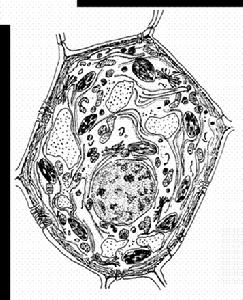中文解釋
Chromoplasts是質負責色素的合成和貯存。他們像所有其他質體(包括葉綠體和leucoplasts),是在特定的光合真核生物物種的細胞器發現。
在傳統意義上的Chromoplasts被發現在植物,如水果和花卉的花瓣,他們
 色質體
色質體Chromoplasts合成和存儲如橙色色素胡蘿蔔素,黃色的葉黃素和其他各種紅色顏料;正因為如此,他們的顏色變化取決於它們包含什麼顏料。chromoplasts進化作用可能主要是作為授粉動物(如昆蟲)或通過進食的各色水果的種子散布的誘食。他們可以積累大量的植物,否則水汪汪的部分不溶於水的化合物。一些類胡蘿蔔素在葉綠體中,也被用來作為輔助色素在光合作用中,他們採取行動,增加葉綠素的效率,在收穫光能。當樹葉在秋季變色,這是由於綠色的損失葉綠素揭露這些已經在葉中的類胡蘿蔔素。在這種情況下,產生新的類胡蘿蔔素相對較少。因此,在質與相關的顏料葉片衰老的變化是從積極轉換chromoplasts水果和鮮花中觀察到的有所不同。
應當指出,“chromoplast”一詞是偶爾使用,包括任何色素,主要是為了強調對比各類leucoplasts,這是有沒有顏料的質的質。從這個意義上說, 葉綠體是一個特定類型的chromoplast。“chromoplast”更經常用來表示質與綠色的葉綠素以外的顏料。
英文解釋
Chromoplastsare plastidsresponsible for pigmentsynthesis and storage. They, like all other plastids (including chloroplastsand leucoplasts), are organellesfound in specific photosynthetic eukaryotic species.
Chromoplasts in the traditional sense are found in coloured organs of plants such as fruit and floral petals, to which they give their distinctive colors. This is always associated with a massive increase in the accumulation of carotenoidpigments. The conversion of chloroplasts to chromoplasts in ripening tomato fruit is a classic example.
Chromoplasts synthesize and store pigments such as orange carotene, yellow xanthophyllsand various other red pigments; as such, their color varies depending on what pigment they contain. The probable main evolutionary role of chromoplasts is to act as an attractant for pollinating animals (e.g. insects) or for seed dispersal via the eating of colored fruits. They allow the accumulation of large quantities of water-insoluble compounds in otherwise watery parts of plants. In chloroplasts, some carotenoids are also used as accessory pigments in photosynthesis, where they act to increase the efficiency of chlorophyll in harvesting light energy. When leaveschange color in autumn, it is due to the loss of green chlorophyllunmasking these carotenoids that are already present in the leaf. In this case, relatively little new carotenoids are produced. Therefore, the change in plastidpigments associated with leaf senescenceis somewhat different from the active conversion to chromoplasts observed in fruit and flowers.
It should be noted that the term "chromoplast" is occasionally utilized to include anyplastid that has pigment, mostly to emphasize the contrast with the various types of leucoplasts, which are those plastids that have no pigments. In this sense, chloroplastsare a specific type of chromoplast. Still, "chromoplast" is more often used to denote those plastids with pigments other than the green of chlorophyll.
